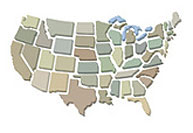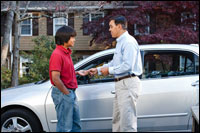Teen Drivers: Safe to and from Prom…and Beyond
 Like going to prom, learning to drive is one of life's milestones. Parents can serve an important role by encouraging teen driver safety to and from prom—and throughout the year.
Like going to prom, learning to drive is one of life's milestones. Parents can serve an important role by encouraging teen driver safety to and from prom—and throughout the year.
 Know Teen Drivers' Risks
Know Teen Drivers' Risks
Parents are concerned about protecting their teen's health and safety. But not everyone realizes that motor vehicle crashes are the leading cause of death for U.S. teens:
- In 2006, 3,490 young people ages 15 to 20 -- an average of more than nine a day-- died in motor vehicle crashes, and another 272,000 were injured.
Overall, younger drivers lack experience on the roads and are less likely than older drivers to recognize risky situations. While lack of experience increases teens' crash risk, so does driving with teen passengers while unsupervised. As the number of teen passengers goes up, so does the risk of a crash.
Fortunately, there are proven ways to reduce teen drivers' risk on the roads. Graduated driver licensing (GDL) systems, combined with parental management, can make a positive difference and make your teen a safer driver.
Know How Much Parents Matter
Is your teen driving or riding with other teens to prom?
Whether your teen's prom is this season or on the horizon, know that you can play a key role in influencing his or her road safety behavior—on prom night and at all times. As a parent or guardian, you're in a unique position as a driving teacher, supervisor and role model. You make the rules about when, where, and with whom your teen can drive. You can also help reinforce important messages about the importance of using seatbelts and the risk of alcohol-impaired driving.

Find state-specific information on your GDL laws.
Typically, the three stages of GDL are:
1. A minimum supervised learner's period.
2. An intermediate license (once the driving test is passed) that limits unsupervised driving under high-risk conditions, such as night-driving or driving with other teen passengers.
3. A full-privilege drivers license after completion of the previous stages.
Remember, as a parent, you make the rules about your child's driving. You can help enforce laws and rules:
Know—and make sure your teen knows—that no alcohol is the law for young drivers.
In 2006, more than one in four young drivers killed in motor vehicle crashes had been drinking. The severity of crashes increases when alcohol is involved. Drinking drivers are also less likely to wear seat belts.
Know How GDL Works
GDL laws differ by state, but the primary goal and format is the same across the country. Graduated licensing is a three-step process developed to let new teen drivers get their initial experience under low-risk driving conditions.
GDL programs are designed to improve teens' safety and reduce their crash risk. Research has shown that the most comprehensive GDL systems are associated with motor-vehicle crash reductions of up to 40%.
More Information
 Facts and Resources about Teen Drivers
Facts and Resources about Teen Drivers - Resources for Parents
- General Information About GDL
- The Council of State Governments Toolkit for Graduated Driver Licensing

- World Day of Remembrance for Road Traffic Victims
- Help Your Teen Driver Stay Safe (
 2:32 min)
2:32 min) - Prom Health and Safety Tips Podcast (
 4:07 min)
4:07 min) - Protect the Ones You Love: Road Traffic Injuries
- Send an eCard: Teen Drivers & Prom
- Send an eCard: Safe Driving for Prom
Current Features
Need info on a
different topic? See


